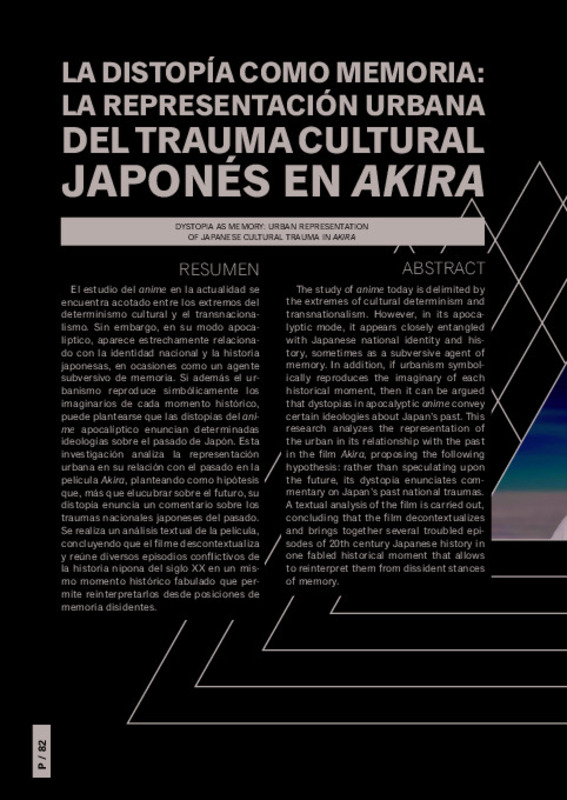BARBER, Stephen, 2006 [2002]. Ciudades proyectadas: Cine y espacio urbano, trad. castellano R. Jackson, Barcelona: Gustavo Gili (Projected cities: Cinema and urban space, Londres: Reaktion Books).
BARTAL, Ory, 2016. “From Hiroshima to Fukushima: Comics and animation as subversive agents of memory in Japan”, en ATARIA, Yochai, GUREVITZ, David, PEDAYA, Haviva, NERIA, Yuval (eds.), Interdisciplinary Handbook of Trauma and Culture, Cham: Springer, pp. 101-115. https://doi.org/10.1007/978-3-319-29404-9_7
BROWN, Steven T., 2006. “Screening anime”, en BROWN, Steven T. (ed.), Cinema Anime: Critical Engagements with Japanese Animation, Nueva York: Palgrave Macmillan, pp. 1-19. https://doi.org/10.1057/9781403983084_1
[+]
BARBER, Stephen, 2006 [2002]. Ciudades proyectadas: Cine y espacio urbano, trad. castellano R. Jackson, Barcelona: Gustavo Gili (Projected cities: Cinema and urban space, Londres: Reaktion Books).
BARTAL, Ory, 2016. “From Hiroshima to Fukushima: Comics and animation as subversive agents of memory in Japan”, en ATARIA, Yochai, GUREVITZ, David, PEDAYA, Haviva, NERIA, Yuval (eds.), Interdisciplinary Handbook of Trauma and Culture, Cham: Springer, pp. 101-115. https://doi.org/10.1007/978-3-319-29404-9_7
BROWN, Steven T., 2006. “Screening anime”, en BROWN, Steven T. (ed.), Cinema Anime: Critical Engagements with Japanese Animation, Nueva York: Palgrave Macmillan, pp. 1-19. https://doi.org/10.1057/9781403983084_1
CARMONA, Matthew, SAKAI, Aya, 2014. “Designing the Japanese city: An individual aesthetic and a collective neglect”, en Urban Design International, vol. 19, no. 3, pp. 186-198 (https://doi.org/10.1057/udi.2013.29 [acceso: mayo, 2022]).
FERRER VENTOSA, Roger, 2020. “Hortus conclusus posmodernos: El refugio de los tecnócratas; Representaciones del estatus social en el urbanismo y la arquitectura tal y como han quedado reflejadas en el cine del capitalismo avanzado (hacia 1980-)”, en El Futuro Del Pasado, vol. 11, pp. 527-546 (https://doi.org/10.14516/fdp.2020.011.018 [acceso: mayo, 2022]).
FRASER, Benjamin, 2016. “El cine, la ciudad, lo urbano: Apuntes desde los estudios culturales urbanos”, en Hispanófila, vol. 177, pp. 263-276 (https://www.jstor.org/stable/10.2307/90012347 [acceso: mayo, 2022]). https://doi.org/10.1353/hsf.2016.0043
FUJIKI, Kosuke, 2015. “My neighbor Totoro: The healing of nature, the nature of healing”, en Resilience: A Journal of the Environmental Humanities, vol. 2, no. 3, pp. 152-157 (https://www.muse.jhu.edu/article/614508 [acceso: mayo, 2022]). https://doi.org/10.5250/resilience.2.3.0152
IMBERT, Gérard, 2019. Crisis de valores en el cine posmoderno: (más allá de los límites), Madrid: Cátedra.
JAMESON, Fredric, 1991. Postmodernism, or, the cultural logic of late capitalism, Londres: Verso. https://doi.org/10.1215/9780822378419
LUKINBEAL, Chris, SHARP, Laura, 2019. “Imagined Cities (Cinema)”, en ORUM, Anthony M. (ed.), The Wiley Blackwell Encyclopedia of Urban and Regional Studies, Hoboken: Wiley, pp. 1-4. https://doi.org/10.1002/9781118568446.eurs0155
MACCANNELL, Juliet Flower, 2001. “Las Vegas: The post-cinematic city”, en Performance Research, vol. 6, no. 1, pp. 46-64 (http://doi.org/10.1080/13528165.2001.10871766 [acceso: mayo, 2022]).
NAPIER, Susan J., 2005 [2001]. Anime from Akira to Howl’s Moving Castle: Experiencing contemporary Japanese animation, Nueva York: Palgrave Macmillan (Anime from Akira to Princess Mononoke, Nueva York: Palgrave Macmillan).
ROBERTSON, Jennifer, 1988. “Furusato Japan: The culture and politics of nostalgia”, en International Journal of Politics, Culture, and Society, vol. 1, no. 4, pp. 494-518 (https://www.jstor.org/stable/20006871 [acceso: mayo, 2022]). https://doi.org/10.1007/BF01390685
ROJAS-SIERRA, Sergio Daniel, 2018. “La narrativa cinematográfica de Makoto Shinkai: Desarrollo de una hipótesis de trabajo”, en Jangwa Pana, vol. 17, no. 1, pp. 73-84 (http://doi.org/10.21676/16574923.2298 [acceso: mayo, 2022]).
SIMMEL, Georg, 2005 [1903]. “The Metropolis and Mental Life”, en LIN, Jan, MELE, Christopher (eds.), The Urban Sociology Reader, Abingdon: Routledge, pp. 23-31.
WADA-MARCIANO, Mitsuyo, 2012. Japanese cinema in the digital age, Honolulu: University of Hawai‘i Press. https://doi.org/10.21313/hawaii/9780824835941.001.0001
YUI, Kiyomitsu, 2010. “Japanese animation and glocalization of sociology”, en Sociologisk Forskning, vol. 47, no. 4, pp. 44-50 (https://www.jstor.org/stable/20853739 [acceso: mayo, 2022]). https://doi.org/10.37062/sf.47.18472
[-]









